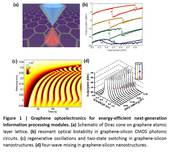Highlight
Graphene optoelectronics for energy-efficient next-generation information processing modules
Achievement/Results
The unique linear and massless band structure of graphene, in a purely two-dimensional Dirac fermionic structure, have led to intense research spanning from condensed matter physics to nanoscale device applications covering the electrical, thermal, mechanical and optical domains. Here we report three consecutive first-observations in graphene-silicon hybrid optoelectronic devices: (1) ultralow power resonant optical bistability; (2) self-induced regenerative oscillations; and (3) coherent four-wave mixing, all at a few femtojoule cavity recirculating energies. These observations, in comparison with control measurements on solely monolithic silicon cavities, are enabled only by the dramatically-large and ultrafast third-order nonlinearities in graphene and the large Q/V ratios in wavelength-localized photonic crystal cavities. These third-order nonlinear results demonstrate the feasibility and versatility of hybrid two-dimensional graphene-silicon nanophotonic devices for next-generation chip-scale high-speed optical communications, radio-frequency optoelectronics, and all-optical signal processing.
Address Goals
This is a cross-disciplinary discovery on the optoelectronic properties of graphene for advanced communication and information processing modules, integrated on a silicon CMOS infrastructure platform.






